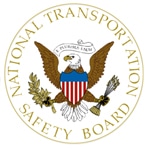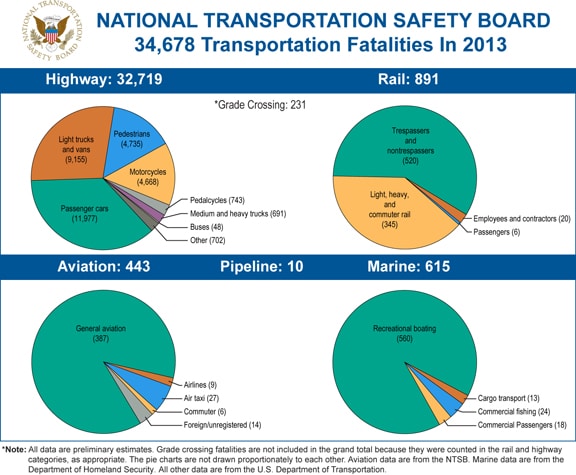 WASHINGTON – Transportation fatalities in the United States decreased by 3 percent in 2013 from 2012, according to preliminary figures released today by the National Transportation Safety Board.
WASHINGTON – Transportation fatalities in the United States decreased by 3 percent in 2013 from 2012, according to preliminary figures released today by the National Transportation Safety Board.Fatalities in all modes of transportation totaled 34,678 in 2013, compared with 35,796 in 2012. Deaths in marine, aviation, highway and pipeline transportation decreased, although there was a rise in rail deaths.
“While this decrease represents a good trend, much more work needs to done, because 35,000 deaths is very troubling,” said NTSB Acting Chairman Hart. “NTSB continues to address safety issues in all modes to reduce deaths and injuries on our roads, rails and waterways, as well as in our skies.”
The 2013 statistics show:
- U.S. roadway deaths, which account for nearly 94 percent of all transportation deaths, decreased from 33,782 in 2012 to 32,719 in 2013. Fatalities on buses were up from 39 in 2012 to 48 in 2013.
- Railroad deaths increased 6 percent from 840 to 891. The vast majority of these fatalities continue to be trespassers struck by trains.
- Aviation deaths decreased from 451 to 443. Nearly 87 percent of aviation fatalities occurred in general aviation accidents (387), a decrease from the previous year (440). In 2013, air taxi fatalities increased significantly from nine in 2012 to 27.
- Marine deaths also dropped in 2013, from 711 to 615. The vast majority of the fatalities, (560), occurred in recreational boating which also decreased.
Aviation statistics are tracked and compiled by the NTSB. The U.S. Department of Homeland Security provides marine statistics, and the U.S. Department of Transportation provides statistics for all other modes.?
Statistical Tables
2012–2013 U.S. Transportation Fatalities | ||||
2012 | 2013 (footnote1) | |||
Highway: | Passenger cars | 12,361 | 11,977 | |
Light trucks and vans | 9,418 | 9,155 | ||
Pedestrians | 4,818 | 4,735 | ||
Motorcycles | 4,986 | 4,668 | ||
Pedalcycles (footnote 2) | 734 | 743 | ||
Medium and heavy trucks | 697 | 691 | ||
Buses | 39 | 48 | ||
Other (footnote 3) | 729 | 702 | ||
Total, Highway | 33,782 | 32,719 | ||
Grade Crossings: (footnote 4) | (230) | (231) | ||
Rail: | Intercity (footnote 5) — | |||
Trespassers and nontrespassers (footnote 6) | 490 | 520 | ||
Employees and contractors | 19 | 20 | ||
Passengers | 5 | 6 | ||
Transit (footnote 7)— | ||||
Light, heavy, and commuter rail | 326 | 345 | ||
Total, Rail | 840 | 891 | ||
Marine: | Recreational boating | 651 | 560 | |
Cargo transport | 9 | 13 | ||
Commercial fishing (footnote 8) | 34 | 24 | ||
Commercial passengers | 17 | 18 | ||
Total, Marine | 711 | 615 | ||
Aviation: | General aviation | 440 | 387 | |
Airlines | 0 | 9 | ||
Air taxi | 9 | 27 | ||
Commuter | 0 | 6 | ||
Foreign/unregistered (footnote 9) | 2 | 14 | ||
Total, Aviation | 451 | 443 | ||
Pipeline: | Gas | 9 | 9 | |
Liquids | 3 | 1 | ||
Total, Pipeline | 12 | 10 | ||
Total | 35,796 | 34,678 | ||
1 Numbers for 2013 are preliminary estimates. Aviation data are from the NTSB; marine data are from the U.S. Department of Homeland Security; all other data are from the U.S. Department of Transportation (DOT). 2 Includes bicycles or other cycles. 3 Includes vehicle non-occupants other than pedestrians and occupant fatalities in other vehicle types, such as farm or construction equipment. 4 Grade crossing fatalities are not counted as a separate category for determining the grand total because they are included in the highway and rail categories, as appropriate. 5 Data reported to Federal Rail Administration (FRA). 6 Includes persons on railroad property without permission (trespassers) and with permission, such as repair personnel (nontrespassers). Does not include motor vehicle occupants killed at grade crossings. 7 Data reported to Federal Transit Administration (FTA). Fatalities for commuter rail operations may also be reported to the FRA and may be included in the intercity railroad fatalities. 8 Refers to operational fatalities. 9 Includes non-U.S. registered aircraft involved in accidents in the United States. | ||||
Related News
- New Jersey Train Length, Crew Size Law Awaits Governor’s Signature
- CSX Conductor, Single Mother Devastated in Head-on Collision
- Union Mourns the Loss of Brother Charles Harrison
- FRA Issues Grade-Crossing Safety Advisory
- Amtrak To Give SMART-TD Members Holiday Bonuses
- Value of Unions
- 2026 Railroad Retirement and Unemployment Insurance Tax Changes
- SMART-TD Members on UP Properties Ratify Five-Year Agreement
- Railroader’s Son to Perform at Carnegie Hall
- Rail Trespassing and Suicide Fatalities Up 70%
